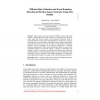Free Online Productivity Tools
i2Speak
i2Symbol
i2OCR
iTex2Img
iWeb2Print
iWeb2Shot
i2Type
iPdf2Split
iPdf2Merge
i2Bopomofo
i2Arabic
i2Style
i2Image
i2PDF
iLatex2Rtf
Sci2ools
GISCIENCE
2010
Springer
2010
Springer
Efficient Data Collection and Event Boundary Detection in Wireless Sensor Networks Using Tiny Models
Using wireless geosensor networks (WGSN), sensor nodes often monitor a phenomenon that is both continuous in time and space. However, sensor nodes take discrete samples, and an analytical framework inside or outside the WSN is used to analyze the phenomenon.. In both cases, expensive communication is used to stream a large number of data samples to other nodes and to the base station. In this work, we explore a novel alternative that utilizes predictive process knowledge of the observed phenomena to minimize upstream communication. Often, observed phenomena adhere to a process with predictable behavior over time.We present a strategy for developing and running so-called `tiny models' on individual sensor nodes that capture the predictable behavior of the phenomenon; nodes now only communicate when unexpected events are observed. Using multiple simulations, we demonstrate that a significant percentage of messages can be reduced during data collection.
Related Content
| Added | 09 Nov 2010 |
| Updated | 09 Nov 2010 |
| Type | Conference |
| Year | 2010 |
| Where | GISCIENCE |
| Authors | Kraig King, Silvia Nittel |
Comments (0)

